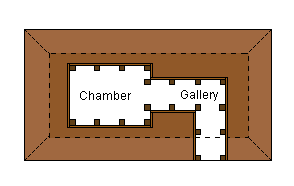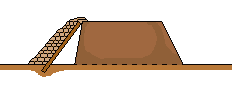Civil War Field Fortifications
Magazines
Theoretical Designs
Magazine Galleries
A Magazine Gallery may be defined as a passageway underneath and protected
by the covering mass that allowed easy access from a trench or the terre-plein
of a fortification to a magazine chamber. For the most part galleries were
constructed using the same materials as chambers, but in smaller proportions
since, being narrower, the burden of the covering mass was not as great and
tended to decrease as they neared the entrance and perimeter of the covering
mass.  Galleries
could be positioned to reach and connect to any convenient unengaged point
on the either the latitudinal or longitudinal chamber walls. Whether
the chamber was raised with its floor at about the natural level of the ground
or sunken into a trench the floor and ceiling of the gallery constructed
along parallel lines in order to preserve overhead clearance throughout its
length. When the chamber was sunken the gallery floor could either be constructed
as a gently rising ramp or cut with a sharper angle and shaped into the treads
and risers of a stairway. Ramps were relatively easier to maintain and removed
the distracting influence steps might have had on troops carrying powder
into and out of the magazine. Stairways were necessary when there was
insufficient space for a ramp and the gallery had to rise rather steeply
from the chamber to the trench or terre-plein.
Galleries
could be positioned to reach and connect to any convenient unengaged point
on the either the latitudinal or longitudinal chamber walls. Whether
the chamber was raised with its floor at about the natural level of the ground
or sunken into a trench the floor and ceiling of the gallery constructed
along parallel lines in order to preserve overhead clearance throughout its
length. When the chamber was sunken the gallery floor could either be constructed
as a gently rising ramp or cut with a sharper angle and shaped into the treads
and risers of a stairway. Ramps were relatively easier to maintain and removed
the distracting influence steps might have had on troops carrying powder
into and out of the magazine. Stairways were necessary when there was
insufficient space for a ramp and the gallery had to rise rather steeply
from the chamber to the trench or terre-plein.
Neither Mahan's Treatise nor Duane's Manual fully treated the
elements of gallery design. Although Mahan mentioned
that magazines
could be sunken, his example designs and illustrations were based on raised
chambers that terminated at the perimeter of the covering mass, in other
words, Mahan's chambers had three interior walls and one side that opened
full onto the terre-plein of the fortification. The open side was to be covered
with a splinter proof shield composed of heavy scantling leaning against
the covering mass to produce two triangular shaped entrances. The inclined
scantling was to be covered with sandbags or soil to absorb the initial impact
of shell fragments or debris striking the shield. Duane's Manual
described a specific gallery design for a fully framed gallery that consisted
of frames made of six inch square scantling with a horizontal clearance of
2' 6" between stanchions and vertical clearance of 4' 6" between the cap
and ground sills. As with the chamber, the gallery was to be given a lining
of planks and roofed with heavy timber or fascines and be buried under the
covering mass.
magazines
could be sunken, his example designs and illustrations were based on raised
chambers that terminated at the perimeter of the covering mass, in other
words, Mahan's chambers had three interior walls and one side that opened
full onto the terre-plein of the fortification. The open side was to be covered
with a splinter proof shield composed of heavy scantling leaning against
the covering mass to produce two triangular shaped entrances. The inclined
scantling was to be covered with sandbags or soil to absorb the initial impact
of shell fragments or debris striking the shield. Duane's Manual
described a specific gallery design for a fully framed gallery that consisted
of frames made of six inch square scantling with a horizontal clearance of
2' 6" between stanchions and vertical clearance of 4' 6" between the cap
and ground sills. As with the chamber, the gallery was to be given a lining
of planks and roofed with heavy timber or fascines and be buried under the
covering mass.
<<< Previous Page
| Next Page
>>>
General Introduction to Magazines
Performance|Gabion
and Fascine|Frame and
Fascine|Fully
Framed|Galleries|Position and Protection
Practical Designs
Siege
Battery|Black
Island|Fort
Creighton|Redan No.
4|Hill
210|Fort
Ward|Btry
McIntosh|Morris
Island
Magazine Failures
Rifle Pits
Blockhouses
Batteries
Back to Minor Works
Contents
Home Page
Major Works
Siege Works
Glossary
Mahan's Principles
Copyright (c) PEM 1997, 1998
 Galleries
could be positioned to reach and connect to any convenient unengaged point
on the either the latitudinal or longitudinal chamber walls. Whether
the chamber was raised with its floor at about the natural level of the ground
or sunken into a trench the floor and ceiling of the gallery constructed
along parallel lines in order to preserve overhead clearance throughout its
length. When the chamber was sunken the gallery floor could either be constructed
as a gently rising ramp or cut with a sharper angle and shaped into the treads
and risers of a stairway. Ramps were relatively easier to maintain and removed
the distracting influence steps might have had on troops carrying powder
into and out of the magazine. Stairways were necessary when there was
insufficient space for a ramp and the gallery had to rise rather steeply
from the chamber to the trench or terre-plein.
Galleries
could be positioned to reach and connect to any convenient unengaged point
on the either the latitudinal or longitudinal chamber walls. Whether
the chamber was raised with its floor at about the natural level of the ground
or sunken into a trench the floor and ceiling of the gallery constructed
along parallel lines in order to preserve overhead clearance throughout its
length. When the chamber was sunken the gallery floor could either be constructed
as a gently rising ramp or cut with a sharper angle and shaped into the treads
and risers of a stairway. Ramps were relatively easier to maintain and removed
the distracting influence steps might have had on troops carrying powder
into and out of the magazine. Stairways were necessary when there was
insufficient space for a ramp and the gallery had to rise rather steeply
from the chamber to the trench or terre-plein.
 magazines
could be sunken, his example designs and illustrations were based on raised
chambers that terminated at the perimeter of the covering mass, in other
words, Mahan's chambers had three interior walls and one side that opened
full onto the terre-plein of the fortification. The open side was to be covered
with a splinter proof shield composed of heavy scantling leaning against
the covering mass to produce two triangular shaped entrances. The inclined
scantling was to be covered with sandbags or soil to absorb the initial impact
of shell fragments or debris striking the shield. Duane's Manual
described a specific gallery design for a fully framed gallery that consisted
of frames made of six inch square scantling with a horizontal clearance of
2' 6" between stanchions and vertical clearance of 4' 6" between the cap
and ground sills. As with the chamber, the gallery was to be given a lining
of planks and roofed with heavy timber or fascines and be buried under the
covering mass.
magazines
could be sunken, his example designs and illustrations were based on raised
chambers that terminated at the perimeter of the covering mass, in other
words, Mahan's chambers had three interior walls and one side that opened
full onto the terre-plein of the fortification. The open side was to be covered
with a splinter proof shield composed of heavy scantling leaning against
the covering mass to produce two triangular shaped entrances. The inclined
scantling was to be covered with sandbags or soil to absorb the initial impact
of shell fragments or debris striking the shield. Duane's Manual
described a specific gallery design for a fully framed gallery that consisted
of frames made of six inch square scantling with a horizontal clearance of
2' 6" between stanchions and vertical clearance of 4' 6" between the cap
and ground sills. As with the chamber, the gallery was to be given a lining
of planks and roofed with heavy timber or fascines and be buried under the
covering mass.